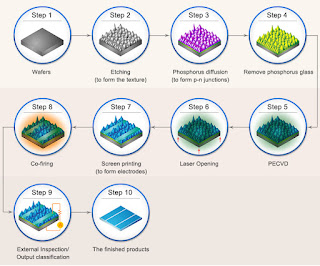Thin Film Solar Panel Technology
Thin film Solar panel technology, sometimes referred to as 2nd generation (low efficiency) and 3rd generation (higher efficiency) has two main aims:
To be cheaper to produce than silicon cell panels (in spite of being an abundant mineral, purified silicon is expensive).
To be more flexible in it's application, enabling the panels to be used in a wider variety of applications.
To be cheaper to produce than silicon cell panels (in spite of being an abundant mineral, purified silicon is expensive).
To be more flexible in it's application, enabling the panels to be used in a wider variety of applications.
Manufacture
As in all cases of thin film panels, the photovoltaic material is not as fragile as thin silicon crystals, the thin film can be printed onto a flexible substrate and can be protected by a flexible transparent layer applied in a similar way.
The solar panels are manufactured by depositing one or more thin layers of the photovoltaic material on to the substrate, which can be glass or a roll of of flexible plastic or metal.
The solar panels are manufactured by depositing one or more thin layers of the photovoltaic material on to the substrate, which can be glass or a roll of of flexible plastic or metal.
Actual methods used to deposit the photovoltaic material vary according to the material used but in some cases may be sprayed or printed on. The finished product, as well as being flexible, is much lighter than silicon crystal cells encased in glass, reducing shipping and mounting costs.
A further advantage of not being encased in glass results from the reduced greenhouse effect and a lower cell temperature leading to increased efficiency at higher ambient temperatures.
Where the thin film is applied to glass, this can be used for windows, providing shading and electrical power.
Materials Used
Photovoltaic materials used in thin film technology include:
Amorphous Silicon - amorphous (non-crystalline) silicon was used in the first thin film to be developed, suffers from low efficiency levels and high production costs.
Cadmium Telluride - has potential problems with the high toxicity of Cadmium and the limited availability (at present) of Tellurium. This method is in current use, with the thin film encapsulated in glass, which will seal in the Cadmium in the event of a fire.
Copper Indium Gallium Selenide, although not proving to be quite as efficient as silicon cells, CIGS have the benefit of cheaper material costs, and can be applied to flexible substrates.
Amorphous Silicon - amorphous (non-crystalline) silicon was used in the first thin film to be developed, suffers from low efficiency levels and high production costs.
Cadmium Telluride - has potential problems with the high toxicity of Cadmium and the limited availability (at present) of Tellurium. This method is in current use, with the thin film encapsulated in glass, which will seal in the Cadmium in the event of a fire.
Copper Indium Gallium Selenide, although not proving to be quite as efficient as silicon cells, CIGS have the benefit of cheaper material costs, and can be applied to flexible substrates.
Photosensitive Dyes
Utilizing a cell known as the Grätzel Cell, named after Michael Grätzel who, together with Brian O'Regan, invented the cell in 1991. The cell to certain extent mimics natures use of chlorophyll to trap sunlight for the production of energy. In this case, a layer of sensitised dye is in contact with a lower layer of titanium dioxide as the semiconductor material. Plus points for these cells are that chemicals (and their production processes) are relatively cheap, and they can produce power at low light levels (cloudy days, or even indoors). Currently, this type of cell can be 11% efficient which is greater than some other thin film technologies.
Problems with the sensitised dye cell arise from the use of a volatile liquid electrolyte which has to be contained although research on the sue of a solid electrolyte is continuing.
Perovskites
Very much in the developmental stage but apparently developing fast, and listed by Science Magazine as one of the top 10 breakthroughs of 2013. The term "perovskite" applies to a particular mineral crystal structure, with the most common mineral of this type being calcium titanium trioxide. Their capabilities for solar cell use have been known since 2009 but at that time they could only be used in liquid form and were of low efficiency. However by 2014 researchers produced semi-transparent solid cells with an efficiency of up to 16%, and it is believed that the efficiency could go as high as 50% with low production costs.

Comments
Post a Comment